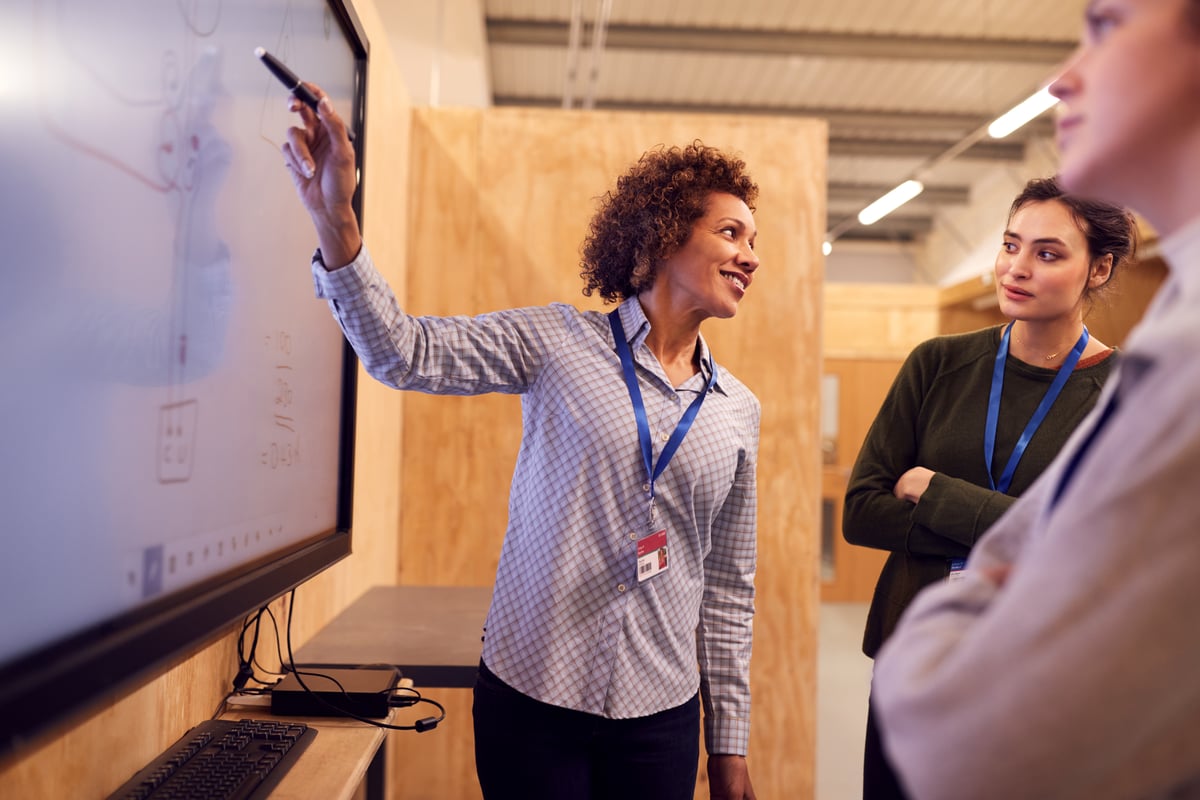Published on
The Growing Role of Community and Industry Partnership in Higher Education

Community and industry partners can help higher ed institutions with many parts of their missions, like helping learners upskill and remain relevant in the market.
Community and industry engagement activities are designed to initiate and steward relationships with external partners. At higher educational institutions, these activities occur whenever we welcome a visitor, hold a community event, give a lab tour, host a career fair, update our websites, post to social media and more; not to mention faculty, staff and others’ thousands of Zooms, emails and phone calls with external partners every day. The number and nature of these activities are hard to overstate. At the University of Arizona, more than 600 faculty have had a research project with an industry component over the last five years, and over 100 staff members have community or industry engagement as part of their job duties, all of which involve substantial time and effort.
So, it’s important to appreciate the ways in which your higher ed colleagues engage with external partners, whether your institution operates with a top-down approach, a decentralized style or something in between, to understand who talks to partners and how those partners may be relevant to your unit’s mission.
I sit within the research enterprise and, at the risk of oversimplifying, my unit’s activities are primarily geared toward securing funding that supports research. However, the interests in community and industry engagement across campus are much broader and often have nothing to do with revenue, as colleagues work to find student internships and develop careers, license technologies, spin out companies, assist local startups, fund athletics, seek philanthropic donations, build community awareness and support agricultural and indigenous communities as the state’s land-grant institution.
Therefore, if you, for example, help working professionals upskill to keep up with industry trends, take the time to understand the dynamics of engagement across your institution to find colleagues who may already have relationships with the companies you’d like to engage.
Challenges to Building Partnerships
One of the challenges to building a network of higher ed colleagues with interests in engagement is not taking away from their mission. That challenge might sound easy but proves more difficult in practice. For example, if multiple colleagues approach the same partner to fund a conference, subsidize a new class or sponsor a workshop, the partner might step back. Your colleagues may be wary of sharing too much and jeopardizing a relationship that took months or years to develop.
Instead, consider approaching colleagues not with a request to meet their partners but a willingness to share information and know-how, for example, software that makes it easy to track relationships, social media tips or best practices for campus visits. The most common request I get from companies is to help them identify talent. Through a history of making introductions to the institution’s career engagement staff, those colleagues in turn come to me when the companies look for more than to hire students.
When you share, you build trust and demonstrate that you want to grow the engagement pie for everyone rather than taking other people’s slices.
Initiating and Maintaining Partnerships
Relationship building might sound daunting. After all, most people in higher ed receive little to no training in engagement. Yet, at its core, partnership development comes down to three elements—marketing, sales and service:
- Marketing: create compelling content to pull potential partners in
- Sales: determine your potential partner’s needs, then find the win-win
- Service: overdeliver to set yourself up for the next opportunity
With those three elements in mind, take advantage of the wealth of information available in traditional business development to translate marketing, sales and service to your institution. Below are lessons that translate well from industry to higher ed.
Partnerships Are Built on Personal Relationships
Connecting with partners on a personal level is still the best way to initiate and maintain relationships. That doesn’t mean you need to take people to dinner or ballgames and remember their birthdays. I did all those things as a consultant, and I’m not convinced they always move the needle. Instead, approach people with empathy. Try to understand what they want to accomplish in their career and how that aligns with their organization’s goals.
When you develop targeted marketing and sales materials for a company, account for their needs. When you see things from the other person’s point of view and genuinely connect with people, you will grow your partnerships.
Repeat Partners Spend More Than First-Time Partners
Sometimes you might question why you spend so much time pursuing a company, even for a small project. Stick with it. A recent business study reported that repeat clients spend nearly 70% more than new clients. That result translates to the academic world. I recently looked at 40 projects our faculty completed for a power utility. On average, the budgets for phase II research projects were nearly 50% higher than the budgets for a phase I project. Once companies find someone they like, budgets get bigger.
That First Project Is the Hardest to Win
Our proposal data from that same power utility show that faculty who apply for a project for the first time win about 30% of the time, but faculty who have worked with the client win about 70% of their proposals. And in that business study linked above, most small businesses reported receiving over half their revenue from repeat customers. If you deliver on what you say, chances are it will be easier to win the next project.
Track the Right Metrics
A traditional business development sales funnel has several stages, moving from identifying potential partners through the first sale and beyond. Depending on your goals for partnerships, metrics will look different. It will be tempting to focus on results like revenue, but you also want metrics that capture overall performance, no matter the outcome. That means using metrics that track the right behaviors. For example, in my unit, we track metrics like substantial engagement, meaning we brought faculty and external decision-makers together, and significant follow-up, meaning we put people face to face (Zoom counts!) after the first meeting. Metrics that track processes and behaviors, not just outcomes, will help you understand where things get held up and what comes next.
Set the Right Expectations
On average, our partnerships take 12 to 18 months, from initial contact to a significant result like a signed research contract. And while the numbers depend on how you count, traditional business development takes seven to ten touches with a new partner before reaching a significant outcome. Finally, roughly 40 to 50% of business development activities stop after the first meeting according to several management consulting studies. So, if all you do is follow up after the first meeting, you’ll be ahead of about half your competition.
Partnerships Change Over Time
One of the best partnerships that helped our learners grew from a relationship with a leading pharmaceutical company that was strictly based on research. Over coffee one day, we had a wide-ranging conversation with our partner about where our research relationship could go, and the partner mentioned the company’s desire to hire more people with diverse backgrounds. We realized their biggest need was new PhDs in the biosciences, which overlapped with our institution’s strengths. That conversation grew into a fellowship program where PhD students now spend six months working on cutting-edge science in world-class labs, and the company gets access to a unique talent pipeline. Even if the students don’t choose to work for the company after graduation, they develop skills that make them more competitive in the market.
The Impacts of Partnerships on Learners and More
The rewards of partnerships can be substantial to the higher ed institution and its community. Besides funding, faculty who work with external partners provide more opportunities for their students, can better translate their research off campus and get access to equipment, facilities and people outside academia. Plus, funding agencies like the National Science Foundation increasingly encourage applied and use-inspired research, which means researchers with industry connections have more opportunities for federal funding. Our institution is fortunate to have an NSF Engineering Research Center (ERC), an NSF Science & Technology Center (STC), a DOE Energy Frontier Research Center and two NSF Industry University Cooperative Research Centers, representing substantial, recurring federal research revenue, none of which would be possible without community and industry participation.
Learners, like potential graduate students, will often select higher ed institutions in part because they have external partnerships, with the thought that curricula, research and other opportunities are relevant to the market and will therefore improve their career opportunities. For example, our institution’s fast-track short courses are developed in collaboration with industry to teach them about the industry itself. And new technologies like AI both encourage students to consider those industries and to better make the transition from learning to employment.
Higher ed institutions increasingly recognize that external engagement can impact nearly all aspects of campus life. After you build a community of practice at your institution, reach out to others through organizations like UIDP to continue developing and refining your approaches to engagement.



